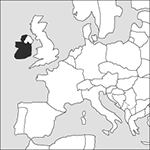
Source: MAPS IN MINUTES™ © RH Publications (1997)
Capital:
Dublin
Area:
70,273 sq km (27,133 sq miles)
Population:
4,775,982 (2013 est)
Currency:
1 euro = 100 cents
Religions:
Roman Catholic 84.7%; Church of Ireland (Anglican) 2.7%; other Christian 2.7%
Ethnic Groups:
Irish 84.5%; other White 9.8%; Asian and Black minorities
Languages:
English, Irish (both official)
International Organizations:
EU; OECD; UN; Council of Europe; OSCE; Euro-Atlantic Partnership Council; WTO
A country in western Europe comprising four-fifths of the island of Ireland, to the west of Great Britain.
Physical
A flat and fertile plain surrounds a central lake, Lough Ree, and the basin of the River Shannon. It is surrounded by coastal areas of great beauty: the Wicklow Mountains in the south-east reach to nearly 1000 m (3300 feet); the Connemara Mountains in the west stand up above great lakes, while those of Kerry in the south-west reach to over 1000 m (3282 feet) and point like rugged fingers to the sea. Many islands, among them Aran, lie in the deep bays of the western coast, where there are sandy beaches among the rocks.
Economy
Formerly dependent on agriculture, Ireland now has a diverse economy with industry and services predominant. Major exports include machinery and equipment, computers, chemicals, medical devices, pharmaceuticals, and food and animal products. A favourable tax regime has made Ireland the European base of several multinational corporations, especially in the information technology sector. A long boom from the 1990s was followed by a financial and economic crisis after 2008.
History
After years of intermittent fighting, the Anglo-Irish Treaty of December 1921, concluded by Lloyd George with the Sinn Fein leaders, gave separate dominion status to Ireland (as the Irish Free State) with the exception of six of the counties of Ulster, which formed the state of Northern Ireland. Irish republicans led by de Valera rejected the agreement and fought a civil war against the Irish Free State forces, but were defeated in 1923. After the Fíanna Fáil victory in the election of 1932, de Valera began to sever the Irish Free State’s remaining connections with Great Britain. In 1937 a new constitution established it as a sovereign state with an elected president; the power of the British Crown was ended and the office of governor-general abolished. The title of Irish Free State was replaced by Ireland (in Irish, Eire). An agreement in 1938 ended the British occupation of certain naval bases in Ireland. Having remained neutral in World War II, Ireland left the Commonwealth of Nations and was recognized as an independent republic in 1949. De Valera was elected President in 1959. He was succeeded as Taoiseach (Prime Minister) by Sean Lemass (1959–66) and Jack Lynch (1966–73). In 1973 Ireland joined the European Community (now the European Union) and a Fine Gael–Labour coalition led by Liam Cosgrave came to power. Subsequent governments were controlled alternately by the Fíanna Fáil under Charles Haughey (1979–81; 1982; 1987–92) and the Fine Gael–Labour coalition under Dr Garret Fitzgerald (1981–82; 1982–87). In November 1985 Ireland signed the Anglo-Irish Accord (the Hillsborough Agreement) giving the republic a consultative role in the government of Northern Ireland. The election as President, in December 1990, of Mary Robinson, of the Irish Labour Party, represented a move towards greater liberalism within Irish society. In 1992 Haughey was replaced by Albert Reynolds, who resigned in 1994 following the collapse of his coalition. The Fine Gael leader, John Bruton, became Prime Minister at the head of a new coalition. In December 1993 Albert Reynolds had joined the UK Prime Minister John Major in issuing the Downing Street Declaration, which set out general principles for the holding of future peace talks on Northern Ireland and represented a significant step towards peace in the province. The Republic was subsequently a party to the 1998 peace agreement (see northern ireland), by which it relinquished its constitutional claim to Northern Ireland. Ireland adopted the euro as its currency in 2002. The Credit Crunch led to a financial crisis in 2008, when Ireland’s six domestic banks faced insolvency. The state assumed their liabilities, but found them too great. Several savage austerity budgets and, in 2010, a loan from the IMF and the EU, were required to stabilize Ireland’s finances (see eurozone crisis). By the end of 2013, the administration had managed to complete the EU/IMF bailout programme. Fine Gael, led by Enda Kenny, either in coalition or as a minority government, has formed the government since 2011.
In 2010 Pope Benedict XVI apologized for many cases, spanning many decades, of sexual abuse of children by Roman Catholic clerics in Ireland. In a referendum in 2015 over 62 per cent of voters voted in favour of legalizing same-sex marriage, the first country in the world to give approval for such a move through a popular vote. Tthe change in social attitudes, and the decline in influence of the Roman Catholic Church, was further underlined when a 2018 referendum resulted in a large majority (66%) in favour of repealing a constitutional amendment that effectively outlawed abortion. .
- buta-1,3-diene
- butanal
- butane
- butanedioic acid
- butanoic acid
- butanol
- butanone
- butatriene
- Butcher–Oemler effect
- Bute, John Stuart, 3rd Earl of (1713–92)
- Butenandt, Adolf Friedrich Johann
- butene
- butenedioic acid
- butex process
- Buthelezi, Chief Mangosuthu (1928)
- Butler, Joseph (1692–1752)
- Butler matrix
- Butlerov, Alexander Mikhailovich (1828–86)
- Butler, Richard Austen (1902–82)
- Butler, Samuel (1835–1902)
- Butler–Volmer equation
- butte
- buttercup
- butterflies
- butterfly